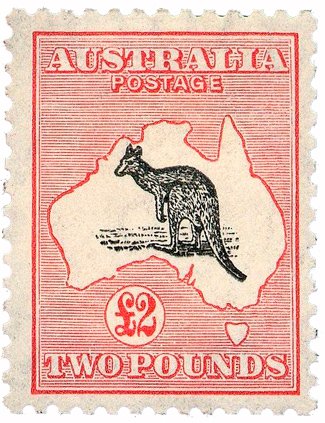On this day in history: Australia’s first stamp released

THE FIELD OF PHILATELY, or stamp collecting, has attracted a remarkable following considering the humble origins of each stamp. Today, 2 January, the Australian stamp-collecting community will be celebrating the 98th anniversary of their country’s first official stamp being issued.
In 1913 a red 1d (one penny) stamp bearing a kangaroo and a map of Australia superseded the Commonwealth colony stamps being used in individual states.
However, it didn’t enter circulation without controversy. It was lampooned at the time for being a weak example of Australian culture and created great divides within the relatively newly independent Federation of Australia as to whether the stamp should include the profile of the king, or indeed any British royal symbols.
It was designed as the ultimate result of a stamp design competition held by the Postmaster-General’s Department. The competition was launched in January 1911, and attracted 1051 designs by 533 entrants.
First stamp a kangaroo with Australian map
The first prize of £100 was awarded in May to Hermann Altmann, from Victoria, whose design featured a full-face portrait of King George V, complete with six shields bearing the insignia of each state, a kangaroo and an emu. Second place, with a prize of £50, was tied by Donald Mackay and Edwin Arnold, both of England. Mackay’s stamp bore the Coat-of-Arms and Arnold’s kangaroo.
However, in October, Charles Frazer became the new Postmaster-General. He took an interest in stamps and was shown the winning entries. Later, describing it to Parliament as “execrable”, he swiftly rejected Altmann’s design, and appointed the Victorian Artist’s Association to find an artist to create a new stamp. They commissioned a local watercolour artist, Blamire Young, who began working on the design while Frazer publicly hinted to the press: “If a picturesque stamp can be provided in which an outline of Australia is featured, I am certainly favourably inclined towards it.”
After Young submitted several designs to the Post Office, Frazer took a liking to the ones with kangaroos, finding them to be an apt representation of the Commonwealth, and wrote a note: “1. Get coastline of Aust. 2. Insert Baldy’s Roo (Edwin Arnold, one of those tied for second place in the competition). 3. Produce in colours for different denominats.”
After some more minor changes, the final design was ready by early 1912, though not without some mishaps, including one print that accidentally omitted Tasmania. Frazer, proud of the finished product, announced the design on 2 April, well before the stamp went on sale on 2 January, 1913.
Back to the original stamp
In June 1913, however, the Labour government which supported Frazer was toppled in a federal election. Agar Wynne, the Liberal government’s new Postmaster-General, announced the kangaroo-and-map stamp was to be replaced by Hermann Altmann’s 1911 competition-winning stamp after all. But it proved to be too complex, so a simpler design featuring the Royal portrait was produced, and issued in December 2013.
Frazer defended his stamp, saying “A postage stamp is one of the best advertising mediums the country can have,” and arguing that an Australian stamp with a British monarch doesn’t represent Australia.
“It is ironic,” says Richard Breckon, from the Australian Philatelic Federation, “considering the circumstances surrounding the kangaroo and map and George V designs, that stamps of both series co-existed for a quarter of a century. Following the accession of King George VI, a full series of new stamps was issued in 1937-38. The end had come for the earlier stamps, except that for some reason the 2s Kangaroo-and-map stamp was not replaced at this time. This last survivor of Charles Frazer’s wish to create ‘an advertisement for Australia’ lingered on until its eventual withdrawal in 1948.”
The kangaroo-and-map stamp will enjoy its centenary in 2013, commemorated by an FIP World Stamp Exhibition in Melbourne from 10-15 May.
For more information on the celebration of the Kangaroo and Map in 2013, go to www.australia2013.com.
RELATED STORIES

